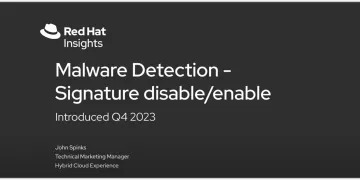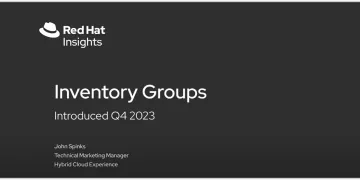이 동영상 정보
Burr Sutter and Preethi Thomas of Red Hat discuss the Podman and Buildah daemonless container tools for Red Hat Enterprise Linux episode 3 of Red Hat's Technically Speaking.
- 실행 시간
- 3:16
- 영상 게재일
자막
[Burr] Today I'm super excited to talk with Preethi Thomas. She's a manager of software engineering here at Red Hat. So can you describe more what the container use cases are within the context of the operating system. Why are containers important to the Linux host?
[Preethi] It's really for container rights station, you can actually have your applications run on specific containers. You don't have to use your whole system to run an application. So that's specifically the, I mean whatever every container technology is so popular because of that, because you don't have to use the whole CPU running your, the particular application.
[Burr] So basically if you think about it from a large server piece of hardware with the context of containers running within the operating system I can have multiple applications multi-tenant kind of way. Right taking advantage of that same set of CPU. So greater density, is that one way to think of it?
[Preethi] Yes, yeah, greater density.
[Burr] Okay, tell me more about Podman, what the use cases are and what you would use that for?
[Preethi] Anything that you use Docker for Podman replaces that and there's no daemon, so it's a daemonless container application. And it's more secure we can use it without root access so that is pretty much the beauty of Podman.
[Burr] I often think of root as god mode, they have the ability to take over everything within the operating system. And that includes a server, a server operating system where you might have hundreds, if not thousands of users leveraging that server operating system. Okay, so I see what you're saying there, basically, I can build a container without having root access. What's the difference between Podman and Buildah?
[Preethi] Podman is really where you can deploy and run containers with and use the CLI, it's really the command line interface and then Buildah uses, it's where you can use to build your images that Podman can use to run.
[Burr] Okay, so if I'm doing a Podman build on the command line that would actually use Buildah underneath the covers?
[Preethi] That's correct.
[Burr] This is not a Red Hat only thing?
[Preethi] No, it's not.
[Burr] It's definitely something we want available to the world at large. So giving them access to Podman and Buildah would be fantastic.
[Preethi] Yeah, absolutely.
[Burr] As it relates to people you manage on a daily basis you work with software engineers who are working on things like Podman and Buildah and these folks are obviously very close to the operating system and very close to how you build an architect software that runs at that level, what would you say is unique about their personalities and their skill set? What does it take to be that operating system type software engineer?
[Preethi] I think adaptability, meaning it's evolving so everything, what people looked for in an operating system 20 years ago when I was starting was not what it is right now so adaptability to being aware of what the industry wants I think is really important.
[Burr] Okay. Well, Preethi it was so nice to meet you today.
[Preethi] Thank you very much for taking the time to talk to me as well I've really enjoyed finally meeting you in person.
[Burr] I know I've never met you in person before so it's been a pleasure for me as well.



